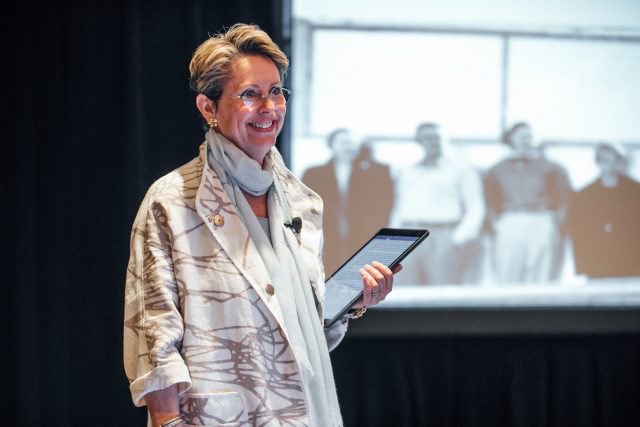Post author Barbara White Bryson speaking at the DFC’s Leadership Summit on Collaboration Across the Design Continuum
This article is copied with permission from DesignIntelligence.
Eric Cesal was frustrated when he graduated from architecture school in the winter of 2008, the year the financial world and architecture world came apart.
In his book, Down Detour Road: An Architect in Search of Practice (2010), Eric observed that architects were among the hardest hit and as a new addition to the profession, he worried, “…the response from architects I knew was typically muted…older architects remembered prior recessions and opined that we will survive this one too.” Even more troubling, he observed, “These exchanges were for me a window into an unsettling aspect of architectural professional culture. We seem to wear these tough times almost as a badge of honor—they reveal how much we love our craft…but we don’t seem to discuss why things are so tough in the first place.”
On our best days, architects understand complex contexts and develop multiple solutions to difficult problems. Design thinking, the empathetic problem-solving methodology, grew, in part, out of our architectural problem-solving design methodologies. Education innovators are also taking lessons from architecture schools. Active learning, making spaces, and student engagement all have roots in the studio process. The rest of the world is learning from our processes, grabbing our best material, and moving on to success and relevance. Architects, on the other hand, are impossibly stagnant in process and perspective, incredibly vulnerable to irrelevance and even extinction. I believe we have been on this road for decades, and we need to make some profound changes if we as architects are to have an impact on the built environment in the future and if we wish to be relevant.
Relevance
Relevance is connected to five critical characteristics:
- size or scope;
- stability;
- connectedness;
- effectiveness; and
- resiliency.
I am concerned about irrelevance and extinction because our profession lacks:
1. Size and Scope
Architects have limited impact. Not only have we left the suburbs, strip centers, and the worst parts of town to others to shape, but we let lawyers and insurers talk us into avoiding risk and retreating from responsibility. It has been estimated that 80 percent of the world is now built without architects and thanks to our reluctance to embrace and manage risk (see the AIA contracts), architects contract for a smaller percentage of project responsibilities than ever before. The current limited scope of architects is in large part a result of being taught “what to think” rather than “how to think” about the business of design and construction. As Indy Johar stated in Future Practice: Conversations from the Edge of Architecture, “Economics is a territory that’s normally relegated to the developer or clients; we don’t seem to worry about the money except how much the building costs.”
To be relevant, we must educate our students and train our interns to be as creative in business as they are in design. We must prepare young architects to imagine revenue flows other than simply asking owners for more fees and to invent better ways of adding value to the processes of planning, design, and construction. If we teach young professionals how to think about the business of design and construction, it will open the door for revenue streams from intellectual property and new services to expand the influence of the problem-solving architect.
2. Stability
Architects have not built a foundation of rigorous original research and knowledge as have other professions. We cannot prove why one building adds more value than another. We cannot prove why we add value. Most architects have never had a rigorous research experience and often are misinformed about the definition of original research. Original research is designed in advance (using an accepted methodology), is systematic in approach, and adds to generalized knowledge.
To be relevant, original research must be developed by and shared within our profession. Research on design processes, design outcomes, and the benefits of design is critically needed to provide a foundation from which our profession may finally argue convincingly in board rooms and owners’ offices why certain processes and decisions add value. I believe that every architecture student must have one original research experience before they graduate. This experience will significantly change how architecture students relate to the world and will improve their ability to add value as professionals.
3. Connectedness
Architects actively insulate our profession with lazy, self-indulgent “archispeak.” In a world where social media and misinformation often reign, it is critical to tell our story clearly and effectively. I am often frustrated, however, when I attend architecture lectures or read architecture articles constructed of made-up polysyllabic words that have no meaning to anyone but a few architectural theory insiders. Alternatively, architects often jump from one “just because I can” example to another without the slightest understanding of storytelling structure or any appreciation of the elegance of plain speaking.
To be relevant, architects must recognize how important it is to connect with the rest of the world, not just in lecture halls but in town halls, conference rooms, interview rooms, and board rooms. We must learn to communicate as clearly and effectively with our words as with our drawings so we can lead, so we can inform, and so we can inspire. Eric Cesal again stated this idea succinctly and eloquently, “Architects should be kings, not sorcerers. Our power should extend from transparent appraisal and demonstrable abilities.” It is time the world understood what we do and HOW we do it.
4. Effectiveness
Many architects do not practice collaboration. Often we talk the talk but we do not walk the walk and we rarely teach real team-building tools or collaborative processes in our colleges. Ester Charlesworth captured an unfortunate truth when she references David Sanderson in her book, Humanitarian Architecture: 15 Stories of Architects Working After Disaster, “‘Architects are often the last people needed in disaster reconstruction,’” she quotes and then observes, “Architects are socialized into making their own personal marks through their design projects,” a characteristic that wasted the time of serious crisis volunteers and, far too often, wastes the time of traditional project teams as well.
To be relevant, we must be dedicated to the success of others as well as to our own success. In the simplest terms, collaboration means “to work jointly with others or together especially in an intellectual endeavor” (merriam-webster.com). But it also means collaborators jointly contribute and share in a manner that contributes to the mutual benefit of the members of a team.
Two troublesome characteristics are indirectly taught to architecture students in school that get in the way of real collaboration. The first is the development of the superior artistic ego that comes, in general, from being taught to solve every problem from scratch. Simply put, there are no original architectural challenges in the 21st century that are simple enough for a single person to resolve on his or her own.
Second, we need to squelch the culture of “I will do anything to practice architecture” masochism learned in the darkest hours of the late night studio and the harshest of the studio critique processes. This masochism creates a mindset that prevents us from asking for what we need to do a job well within the context of collaboration, from being innovative about the process of design or construction, and to negotiate appropriate fees based on value added.
5. Resiliency
Architects often lack a global outlook. There are many U.S. architects working on projects overseas but many of those architects have not reflected upon the profound differences between the speed of change in the rest of the world and the incremental view we have about change here in the United States. Elsewhere, cities or parts of cities appear and disappear in the matter of a year or two or three. In Shanghai and Beijing, there is a super generation of young architects who are getting more experience in a year than most architects in the U.S. are getting in a decade. There are now 15 metropolitan areas in the world with populations over 20 million. Every one of these cities has stunning business districts, but they also have large portions of their populations housed in poor neighborhoods often constructed informally from found materials. In Future Practice, Bruce Mau stated, “We are adding one million people a week to the planet and if the average child is 7 ½ lbs., that’s seven and a half million pounds of flesh every week,” and “the way we will solve this problem is to design new ways of living to accommodate our scale…and we are a million miles away from that.”
In December 2011, in Hunan Province China, the Broad Sustainable Building Company—an off-shoot of a chiller manufacturing company—constructed a 30-story building in 15 days. Nothing like it had been seen by the world before. This was a story about careful planning, process creativity, responding to financial and environmental needs, and speed. The completion of a 57-story building a year ago in just 19 days demonstrated the viability of this same system for very large projects. To be clear, there were months of planning and factory construction prior to the 19 days of site work but, nevertheless, this was an amazing feat, and there was little or no involvement by architects.
To be relevant and to avoid extinction, we must be resilient. We must lift our heads, we must see what is occurring in the world, and we must adapt. We must stop being complacent with our incremental processes, and we must stop reinventing the door or the window or the stairwell. We face big challenges and we must grab the opportunity to build on the knowledge of others even if that knowledge comes from a chiller company creating prefabricated buildings in China.
Avoid Extinction
Architects are the greatest problem-solvers on the planet. Unlike other professions that will go unnamed here, we are not problem-analyzers or problem-debaters. We can and should be relevant by making some small changes to our education and culture. To stay relevant and to avoid extinction our profession must remember:
1. Size matters
Expand our impact by learning to think about the business of design and construction, manage risk, and expand revenue streams.
2. Stability relies on a firm foundation of knowledge built on rigorous research
Provide our young professionals with rigorous research experiences and support research that builds generalized knowledge.
3. Connectedness counts
Learn the art of storytelling and plain speaking so we can compellingly communicate the value of our profession.
4. Effectiveness is everything
Start learning the skills and using the tools of collaboration to make architects the most effective members of every team.
5. Resiliency requires global awareness
Architects must strive to understand the changing competition, pace, and processes of the world.
The next time a recession occurs, perhaps we can give young professionals like Eric Cesal more relevant answers.
Barbara White Bryson is both the managing principal of the Strategic Futures practice of DI Strategic Advisors and the associate dean of the College of Architecture, Planning and Landscape Architecture at the University of Arizona. She also spent 13 years as the associate vice president of facilities engineering and planning at Rice University.
Excerpted from DesignIntelligence Quarterly.







